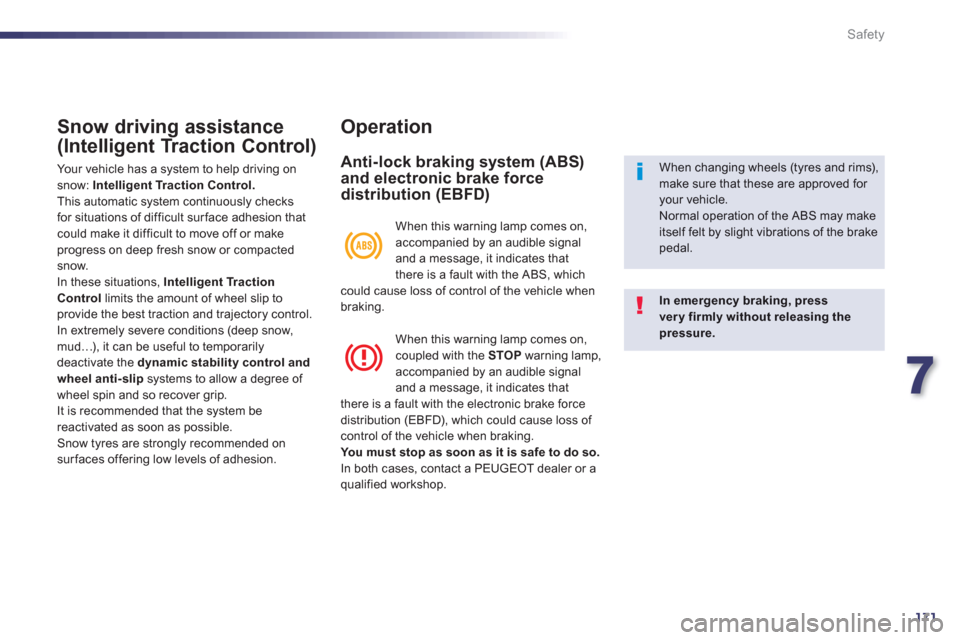Page 172 of 304

170
Safety
Electronic Stability Programme incorporatingthe following systems:
- the anti-lock braking system (ABS) and the
electronic brake force distribution (EBFD),
- the emergency braking assistance,
- the anti-slip regulation (ASR) or traction control,
- the d
ynamic stability control (DSC).
Electronic stability programme (ESP)
Definitions
Anti-lock braking system (ABS)
and electronic brake force
distribution
(EBFD)
This system improves the stability and
manoeuvrability of your vehicle when braking
and provides improved control in corners, in
par ticular on poor or slippery road surfaces.
The ABS prevents wheel lock in the event of emergency braking.
The electronic brake force distribution system
manages the braking pressure wheel by wheel.
Emergency braking assistance
In an emergency, this system enables you to reach the optimum braking pressure more quickly and therefore reduce the stoppingdistance.
It is triggered in relation to the speed at which
the brake pedal is pressed. This is felt by areduction in the resistance of the pedal and an
increase in the effectiveness of the braking.
Anti-slip regulation (ASR)
The ASR system (also known as Traction Control) optimises traction in order to avoid
wheel slip by acting on the brakes of the drivingwheels and on the engine. It also improves
the directional stability of the vehicle onacceleration.
Dynamic stability control (DSC)
If there is a difference between the pathfollowed by the vehicle and that required bythe driver, the DSC monitors each wheel and
automatically acts on the brake of one or more
wheels and on the engine to return the vehicle
to the required path, within the limits of the laws
o
f physics.
Page 173 of 304

7
171
Safety
Snow driving assistance
(Intelligent Traction Control)
Your vehicle has a system to help driving on snow: Intelligent Traction Control. This automatic system continuously checks for situations of difficult surface adhesion thatcould make it difficult to move off or makeprogress on deep fresh snow or compacted snow.
In these situations, Intelligent Traction
Controllimits the amount of wheel slip to provide the best traction and trajectory control.
In extremely severe conditions (deep snow,mud…), it can be useful to temporarilydeactivate the dynamic stability control andwheel anti-slip
systems to allow a degree of
wheel spin and so recover grip.
It is recommended that the system be
reactivated as soon as possible.
Snow t
yres are strongly recommended on sur faces offering low levels of adhesion.
Operation
Anti-lock braking system (ABS)and electronic brake force
distribution (EBFD)
In emergency braking, press very firmly without releasing the pressure.
When changing wheels (tyres and rims),make sure that these are approved for your vehicle.
Normal operation of the ABS may makeitself felt by slight vibrations of the brake pedal. When this warnin
g lamp comes on,
accompanied by an audible signal
and a message, it indicates that
there is a fault with the ABS, which could cause loss of control of the vehicle whenbraking.
When this warnin
g lamp comes on,coupled with the STOPwarning lamp,
accompanied by an audible signaland a message, it indicates that
there is a fault with the electronic brake forcedistribution (EBFD), which could cause loss of control of the vehicle when braking.
You must stop as soon as it is safe to do so.In both cases, contact a PEUGEOT dealer or a qualified workshop.
Page 189 of 304

8
187
Practical information
Wheel with trim
When refitting the wheel
, refit the trim starting by placing its notch facing the valve and press around its edge withthe palm of your hand.
Removing a wheel
Parking the vehicle
Immobilise the vehicle where it does not block traffic: the ground must be level,stable and not slippery. Apply the parking brake unless it has
been programmed to automatic mode,switch off the ignition and put the gear lever in position A
, M
or Rto block the wheels.Check that the braking warning lampand the P
warning lamp in the parking brake control lever come on.The occupants must get out of the vehicle and wait where they are safe. Never go underneath a vehicle raisedusing a jack; use an axle stand.
List of operations
�)
Remove the bolt cover from each of
the bolts using the tool 3 (according to equipment).�)
Fit the security socket 4
on the wheelbrace 1
to slacken the security bolt (if fitted). �)
Slacken the other bolts using the
wheelbrace 1only.
Page 197 of 304
8
195
Practical information
1.Brake lamps (light emitting diodes - LEDs).2.Reversing lamps (W19W).3. Direction indicators (PY21W amber).4.Sidelamps (light emitting diodes - LEDs).5.Foglamps (light emitting diodes - LEDs).
Rear lamps
Direction indicators(on the wings)
�)
Open the boot then remove the accesscover.�)
Remove the sealing foam.�)
Disconnect the lamp connector. �)
Remove the lamp fixing nut.
�)
Carefully remove the lamp unit from outside.�)
Remove the sealing foam. �)
Unclip the bulb holder. �)
Turn the bulb a quar ter of a turn and pull itout.
For reassembly, carry out these operations in
reverse order.
Changing the light emitting diode-LED lamps
For replacement, contact a PEUGEOT dealer or qualified workshop.
Page 199 of 304
8
197
Practical information
Third brake lamp (light emittingdiodes - LEDs)
Contact a PEUGEOT dealer or qualified
workshop.
Number plate lamps
�) Insert a thin screwdriver into one of the outer holes of the lens.�)
Push it outwards to unclip.�)
Disconnect the lamp connector. �)
Remove the lens.�)
Pull the bulb out and change it.
Page 211 of 304
8
209
Practical information
Vehicle recovery
Before doing any work, with the ignition on, press the brake pedal and put the gear selector toposition N, then switch off the hybrid system.
If necessary because access to the vehicle is difficult, it can be moved a few dozen metres at a speed not exceeding 6 mph (10 km/h).
Th
e front or rear wheels must not be on theground, use a flat-bed lorry or trailer to recover
the vehicle.
Use the towing eyes only to pull a vehicle out or
to pull it onto a flat-bed.
Page 213 of 304

8
211
Practical information
Driving advice
Distribution of loads
�)Distribute the load in the trailer so that theheaviest items are as close as possible to
the axle and the nose weight approaches the maximum permitted without exceeding it.
Air density decreases with altitude, thus
reducing engine performance. Above
1 000 metres, the maximum towed load must
be reduced by 10
% for every 1 000 metres of altitude.
Side wind
�)Take into account the increased sensitivity
to side wind.
Cooling
To w i ng a trailer on a slope increases the
temperature of the coolant.
As the fan is electricall
y controlled, its cooling capacity is not dependent on the engine speed. �)
To lower the engine speed, reduce your speed. The maximum towed load on a long incline
depends on the gradient and the ambient
tem
perature.
In all cases, keep a check on the coolant
temperature.
�)If the warning lamp and the STOPwarning lamp come on, stop the
vehicle and switch off the engine
as soon as possible.
Braking
To w i ng a trailer increases the braking distance.
To avoid overheating of the brakes on a long
mountain type of descent, the use of enginebraking is recommended.
Tyres
�)
Check the tyre pressures of the towingvehicle and of the trailer, obser ving the
recommended pressures.
Lighting
�)
Check the electrical lighting and signalling on the trailer.
The rear parking sensors will be deactivated automatically if a genuinePEUGEOT towbar is used.
R
efer to the "Technical Data" section for detailsof the weights and towed loads which apply to your vehicle.
Page 220 of 304
218
Checks
The various caps and covers allow access for checking the levels of the various fluids, for replacing cer tain components and for primingthe fuel system.
Diesel engine
1.
Power steering reservoir.2.
Screenwash and headlamp wash reservoir.3.
Coolant reser voir. 4.
Brake fluid reservoir.5.
Battery / Fuses.
6.Fusebox.7. Air filter.8.Engine oil dipstick. 9.
Engine oil filler cap.10.Priming pump. 11.
Bleed screw.
Before doing anything under the bonnet,switch off the ignition (Readylamp off) to avoid any risk of injury resulting from automatic operation of the engine.